Last night, while reading the small section on gravel gardens in Noel Kingsbury's truly excellent book, Natural Gardening in Small Spaces, it occurred to me that gravel might be the solution I've been looking for.
"The association of stone and plant evokes hot dry climates, and many Mediterranean-climate plants with silver-grey foliage and compact shrubby habit look good, as too do many others we associate with semi-arid climates...Gravel gardens are a very modern solution to some of the age-old problems of the small garden..."Do cats poop on gravel? They don't poop on the gravel in my garden. They seem to poop exclusively on the mulch.
I've been using pea gravel in the cobblestone path since before the garden was planted and I'm pretty happy with it. So far, however, the gravel has not moved in to the beds. The paths get messy and Kingsbury warns against using gravel where there is "high turnover of leaves and stems--too much decaying leaf matter will soon give the gravel a dirty look and encourage weed growth".
The part about looking dirty is certainly true on my garden paths, especially where the fallen bamboo leaves tend to accumulate. Usually, I let organic matter decompose in situ and sprinkle more gravel over the dirty parts while that happens.
Unsustainable? A ticking time bomb? At some point that decomposition will result in soil and some day weeds may sprout in that soil. For the time being however, very few weeds sprout in my garden.
I've admired gravel at the Blake Garden where they use it in paths under big deciduous trees. They seem able to control the scourge of dirty gravel--why couldn't I? And besides bamboo, I don't have a lot of litter-producing plants--especially in the places where the putative cat poops. I have manzanita, eriogonum, perennial bunch grasses, and seasonal wildflowers--all staples of a California dry garden that seem to fit Kingsbury's pro-gravel scheme.
As a pilot experiment, I broadcast a few hand-fulls of the gray pea gravel that I use in the paths around the recently limbed-up mahogany trunks of Arctostaphylos pajaroensis 'Lester Rowntree'.
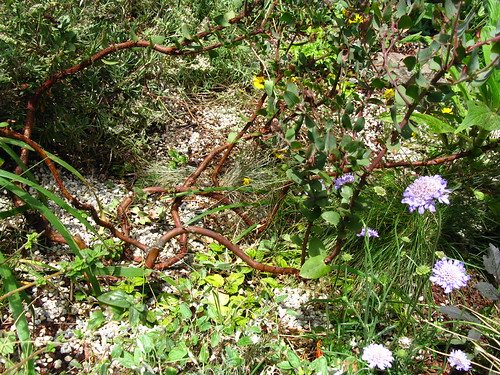
I rather like the contrast. Before, the wood was the same color as the ground underneath, and the two were hard to distinguish. The multi-limbed mahogany trunk is a great feature that goes unnoticed without some contrast. I think a layer of gravel could work here.
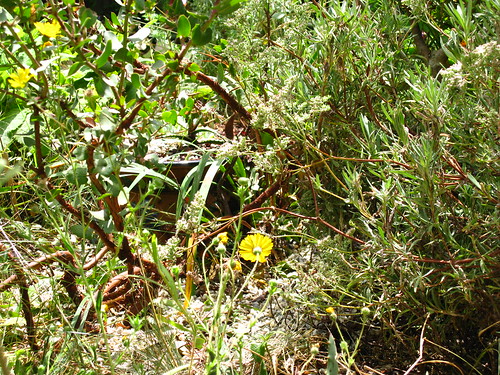
None of these native plants should even need organic mulch.
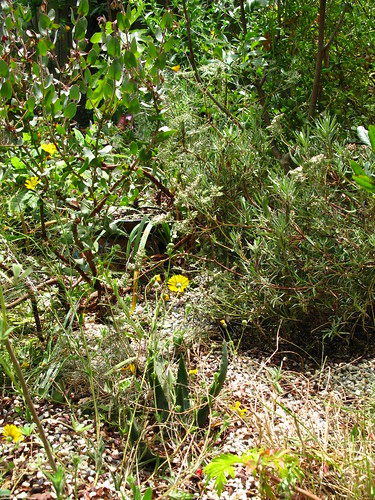
Kingsbury also notes that some seeds, like Verbena bonariensis, germinate particularly well in gravel. I like the sound of that... The threat of weeds frightens some people, but weeds have not been a problem for me. Wildflower seeds germinating "particularly well" in my garden would be fabulous. They certainly have not self-sown very well in my organically mulched garden.
And on the closely related subject of meadows, Kingsbury says something particularly interesting:
"European meadows illustrate an ecological feature that many gardeners find counter-intuitive: the poorer the soil, the better the flora. Fertile soils, especially if moist, are dominated by a limited number of aggressive grass species, and comparatively few decorative forb species are able to compete... On the other hand, less fertile soils, especially if seasonally dry, do not provide good habitat for the strong-growing grasses and will support a rich diversity of attractive forbs. The best wildflower meadows are to be found on thin dry soils overlaying limestone, their sparse turf spangled with colorful flowers."In other parts of the book he advocates amending and enriching the soil for a long show of seasonal annuals (e.g., wildflowers?), and there is some distinction to be made between European and American meadow models, so I will have to read closer.
(Also the tendency to refer to, say, American growing conditions when they mean east coast or Midwest growing conditions is hard for many writers to overcome. California is different than those places with our long summer drought and varying soil types. Californian gardeners have to make some effort to suss out what garden writers really mean and if what they write about even applies to California.)
So while I have more reading to do, I'm thinking about a lot about gravel right now. The closest large stone yard to me has some interesting gravels for what look like fairly cheap prices. I may get some samples to experiment with, in consideration the different plants and colors that I have in my garden as it is right now.
In the meantime...there is prettiness.

Does the Senecio cristobalensis look funky to you?
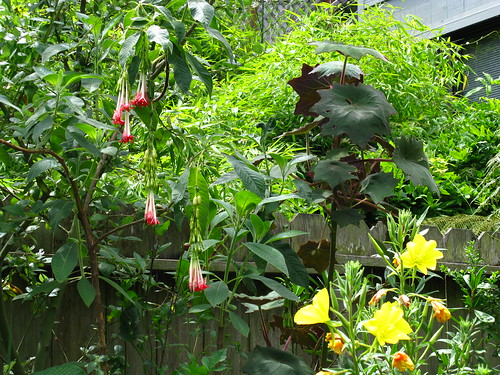
I can't dispute that, but I'm going with groovy.
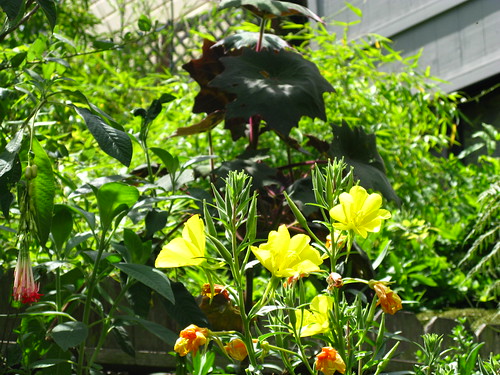
The venation and purple pubescence is definitely groovy.
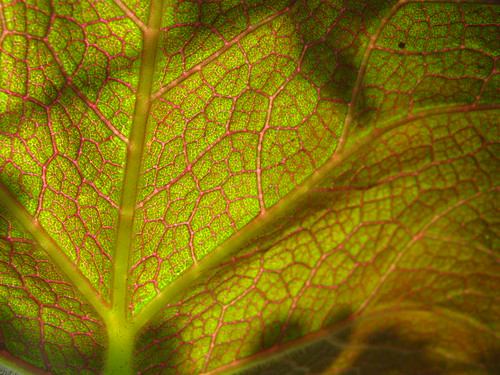
The grape leaves are getting some purple too.
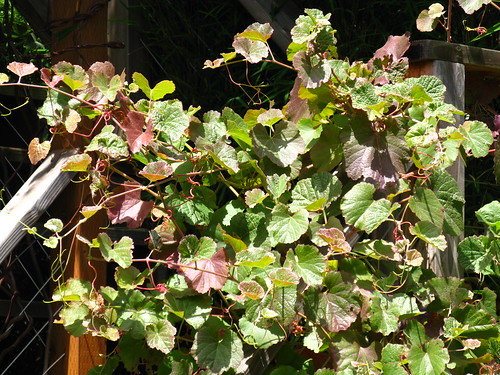
Hang in their grape leaves, it's only August!
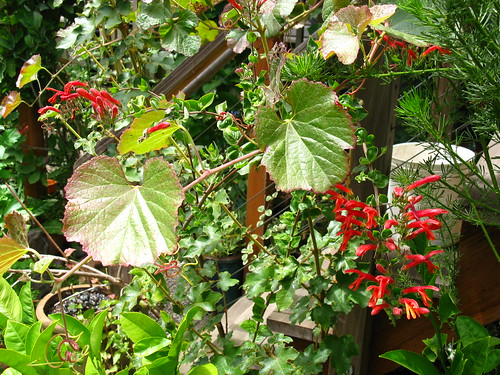
Asclepias curassavica does very well in part-sun, I'm happy (and lucky) to report.
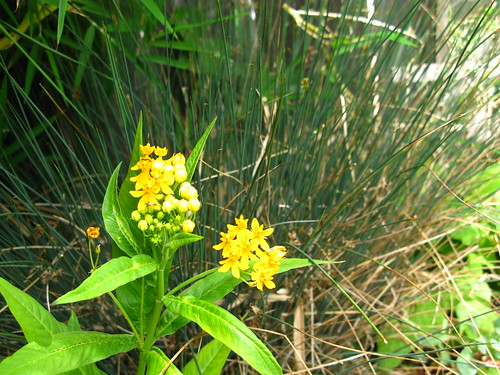
'Charlotte' rose seems to be re-blooming. This bloom opened just this morning and there are several more buds. Groovy!
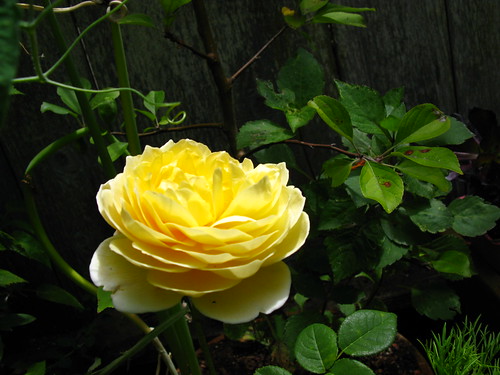
ADDED: In the comments, Emma says cats treat her 3/8" gravel like kitty litter.
Brent cites two LA Times articles (here and here) one of which explains why seeds grow in it:
"Part of the beauty of using gravel in native and Mediterranean planting beds is how the seeds will fall into the rock, then root quickly without mulch or dry soil wicking the moisture away from them."Ah, but of course!

10 comments:
Hi Chuck, you know I have gravel pathways in the garden- 3/8" Desert Gold, and guess what- the neighborhood cats think it's a litter box. When I see flies, I know there's a pile somewhere, and I scoop it up and bury it. They keep the gopher and mouse population down, so I try to look at it that way.
Emma
What about a larger gravel size?
Also, I don't have gophers. But I might have mice.
Emily Green, writing in the LA Times, has recently extolled the virtues of gravel mulch.
http://www.latimes.com/features/home/la-hm-gravel-pictures,0,978775.photogallery
and
http://www.latimes.com/features/home/la-hm-gravelside18-2009jul18,0,342775.story
Excellent--thanks, Brent!
Emma--your gravel is more like decomposed granite, isn't it? We have to talk.
Grr yes cats can be a pita(-: I have pea gravel in my paths and love the look. I do add fresh stuff every couple years but don't seem to have trouble with weeds. Cats seem to love to go where you don't want them to! Most irritating!(-: I need a fresh load of gravel for my paths but am waiting till all the leaves are down this fall then I will rake and apply new gravel(-:
Your sunflowers look awesome. Do you have yellow finches that eat the leaves? I had a bunch come and eat all my sunflower leaves so the plant was really just a stem. That is after I fed the little brats too! They decided they liked the sunflower leaves more then the thistle seeds!!! (-: Oh well. Maybe next year!
Groovy then.
Cats and pooping, my take. First they are going to pick a territory to poop in. Then they will choose options within the chosen territory. Between gravel and mulch, they will pick mulch. Between gravel and another territory they very well could choose gravel in the preferred territory. The other thing kitties like for pooping is enough of an open space to turn around in. I can't imagine you have that much open ground in your garden, but these are city kitties who must prefer actual diggable dirt to concrete. I'm not sure gravel is a solution to this problem.
Gravel is however a wonderful media for outdoor germination and lots of good things are always found in the gravel. That might even be a good idea for me, to have an actual gravel bed to toss seeds in for gernmination and later transplanting.
Dude, I think you have my raccoon! Part 1, and Part 2.
I should say, I *had* a raccoon as I now have one of those motion sensor water sprinkers. (Yes, I am turning into Bill Murray.)
Sorry if I scared him up the hill.
Hi Chuck, I just bought that Kingsbury book too and read through it very fast. Need to go over it again but there was so much good stuff in there I just inhaled it. Yes to the gravel. The cats have not ever pooped in it, including the new pea gravel of the zen garden, but it is larger than 3/8ths inch. I still fear the squirrels trying to bury the walnuts in it though, but it seems like an off year for the nut trees. I love your groovy leaves and the contrasting gravel with the bark. Give gravel a chance! How nice that you have different selections from which to choose, too.
Frances
Chuck, this is interesting because pea gravel was never in my gardening vocab until this year when someone suggested it as a solution for the large spaces in between the flagstones on my terrace. (The rabbits spend all winter chewing on the many ground covers I've tried).
It changed the whole look of the terrace and I'm liking it a lot. I think it really sets off most plants as evidenced by your picture of the mahogany.
Good work with the skeleton keys!
Post a Comment